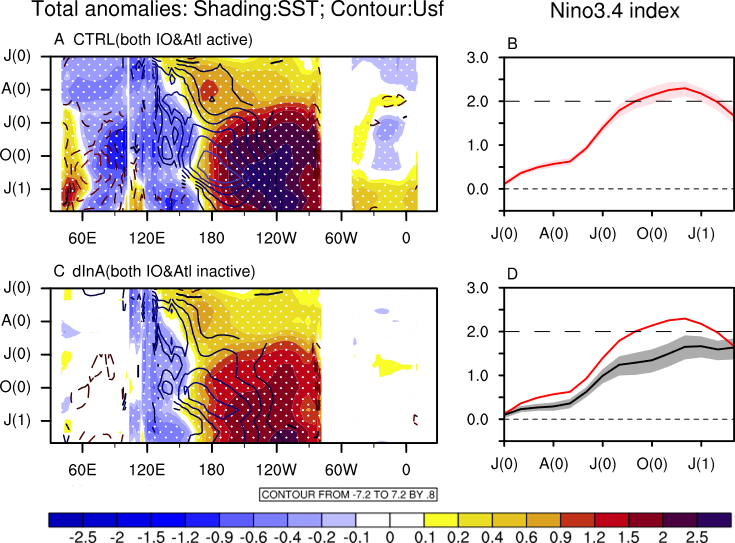Coupling is key for the tropical Indian and Atlantic Oceans to boost super El Niño

Fig. 1. Weakening of equatorial Pacific warming due to the decoupling of Indian and Atlantic Oceans. (A) Composite equatorial (5°S-5°N) SST (shading, °C, with stippling indicating significance at the 95% confidence level) and surface zonal wind (contours, m/s, shown only for the values exceeding the 95% confidence level) anomalies from January (0) to March (1) in the CTRL. (B) Monthly standardized Niño3.4 index from January (0) to March (1) in the CTRL. The solid line displays the composite values, whereas the shading denotes the confidence interval between the 97.5% and 2.5% bounds measured by a 10000-resampling bootstrap method. (C), (D) Similar to (A), (B), except for the results from the dInA. In (D), the black line and shading show the composite values and confident interval of the dInA, while the red line is the composite values of the CTRL.

Fig. 2. Individual and synergistic boost effects of the Indian and Atlantic Oceans on super El Niño. (A) The response of the monthly standardized Niño3.4 index to the individual effect of the Indian Ocean (dAtl minus dInA) from January (0) to March (1). The solid line displays the composite values, whereas the shading denotes the confidence interval between the 97.5% and 2.5% bounds measured by a 10000-resampling bootstrap method. (B) Same as (A), except for the individual effect of the Atlantic (dIO minus dInA). (C) Same as (A), except for the offline summation of the individual effects of the two oceans ((A) plus (B)). (D) Same as (A), except for the synergistic effect of the Indian Ocean with the coupling of the Atlantic (CTRL minus dIO). (E) Same as (A), except for the synergistic effect of the Atlantic with the coupling of the Indian Ocean (CTRL minus dAtl). (F) Same as (A), except for the joint effect of the two oceans (CTRL minus dInA). The schematics above and below the time series of Niño3.4 index show how to calculate the individual and synergistic boost effects.
A member of the CLIVAR Tropical Basin Interaction Research Foci (TBI RF) recently published a paper that highlights the importance of coupled dynamics between the tropical Atlantic and Indian Oceans in shaping and intensifying super El Niño events. Their study, which utilizes a series of global climate model experiments, demonstrates that super El Niño events are driven by a complex interaction among the tropical Atlantic, Indian, and Pacific Oceans.
The study divided the experiments into four groups: the CTRL group, where all three oceans were active; the dIO group, with the Indian Ocean decoupled; the dAtl group, with the Atlantic Ocean decoupled; and the dInA group, where both oceans were decoupled. The findings were striking: without the cross-basin interaction of the Indian and Atlantic Oceans (dInA), the tropical Pacific warming failed to reach the levels necessary for a super El Niño (as observed in the CTRL group). This result underscores the pivotal role of the Indo-Atlantic booster mechanism proposed by Wang and Wang (2021, J. Climate) (Figure 1). Moreover, the experiments distinguished between the effects of individual cross-basin interaction and their combined influence. It was observed that while individual effects were weaker and more uncertain, the combined effects were significantly stronger and more reliable. Specifically, the joint influence of the Atlantic and Indian Oceans was found to more effectively drive tropical Pacific warming (Figure 2). This process is linked to the nonlinear characteristics of convective sensitivity: when both oceans impact the Pacific simultaneously, they more effectively promote the eastward expansion of the Pacific warm pool, enhancing tropical Pacific convection and strengthening the Bjerknes feedback loop, ultimately leading to the formation of a super El Niño event.
Additionally, the Indian and Atlantic Oceans do not always have a positive impact on every super El Niño event. Due to internal variability, SST anomalies in these oceans vary in intensity across super El Niño events and can even create unfavorable conditions that may hinder El Niño development. This research underscores the importance of considering synergistic coupling effects to develop a more comprehensive and precise understanding of the interactions among the three oceans.
(Summary by Di Zhang, edited by Dr Chunzai Wang)
The full article can be accessed from https://www.science.org/doi/full/10.1126/sciadv.adp2281
-------------------------
Fan, H., C. Wang, S. Yang, and G. Zhang, 2024: Coupling is key for the tropical Indian and Atlantic oceans to boost super El Niño. Science Advances, 10, eadp2281, https://doi.org/10.1126/sciadv.adp2281













